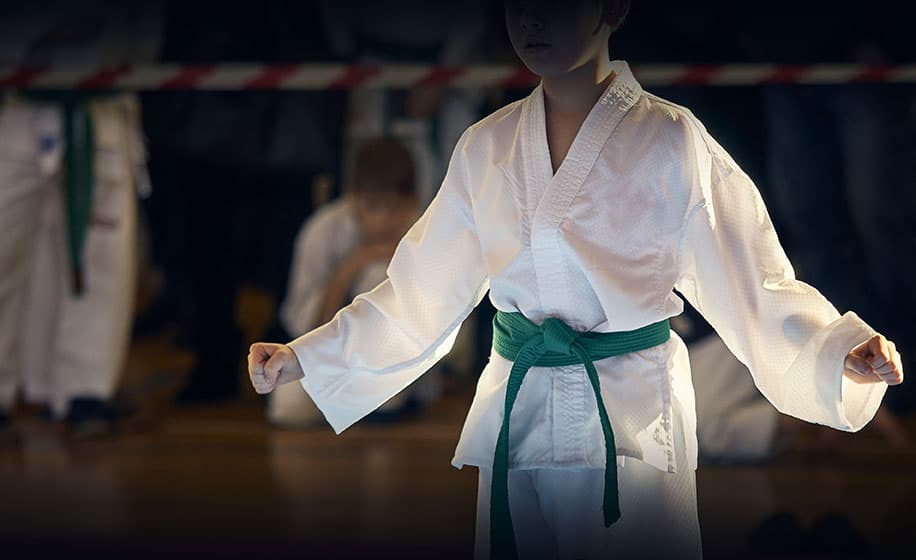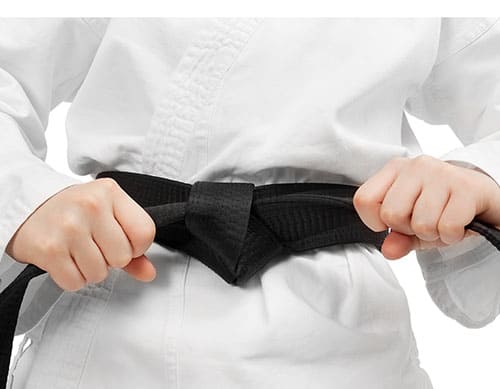 When I started TawKwonDo I had never really given much consideration to the meaning of the belt colors or even what was the order of the belts in TaeKwonDo and the reason(s) for it. I assume that I am not the only one and so with that in mind, I did some research and found the answers to this question.
When I started TawKwonDo I had never really given much consideration to the meaning of the belt colors or even what was the order of the belts in TaeKwonDo and the reason(s) for it. I assume that I am not the only one and so with that in mind, I did some research and found the answers to this question.
History of The Belt System
The belt system in the early days, started with just white, yellow, green, brown and black as these are the six true or natural colors. However, in Tae Kwon Do today the schools have added different color belts such as orange, blue and red each of which you receive as you advance toward ones ultimate goal getting a black belt.
The modern belt system of TaeKwonDo was developed in the early 1940’s and is often symbolized as the growth of a tree or going from a baby to an adult and is a visible means of breaking down the process of going from a white belt (yang ) to getting your 1st degree black belt (yin)
Keep in mind that the belt colors are not standardized and vary somewhat from school to school and all or some may be part of your schools advancement system.
Traditional Belt Levels:
I remember when I firs started that I could not wait till I could wear another belt other then white. I remember being somewhat embarrassed walking up my to class wearing my uniform and holding my white belt.
Of course I did not understand the underlying significance of that belt or all the others for that matter and how they relate to the advancement of a TaeKwonDo student.
As time went on and as I continued to progress in my TaeKwonDo training I became more and more aware of the significance of the colors of each belt and how they were not just haphazardly put together but were thoughtfully arranged in accordance to the growth of the student (or me).
I became aware that these colors each have their own meaning and therefore I soon became proud of each new belt as it signified my growth in this Martial Art.
TaeKwonDo Belt Order and What Each Belt Color Means

White Belt
This is a symbol that means innocence or purity.. All beginning students who have no experience with Tae Kwon Do start with this belt. It represents a clean slate and the beginning of a journey
Yellow Belt
This color signifies the earth and has meaning of a seed being planted in order for its root system to take place as it begins to grow. At this stage the student is beginning to create the foundation of learning Tae Kwon Do
Green Belt
Green Belt has a meaning of growth and how the seed or now plant begins to grow. The student now has the foundation upon which to build upon and students skills in Tae Kwon Do continues to develop.
Brown Belt
Brown belt means that the tree is growing and maturing, just like the student and their techniques and the students skills continue to get better as they move into more advanced techniques.
Blue Belt
Blue belt means a beginning to talk about the sky or heaven to which the plant is growing and on its way to becoming a towering tree. The Tae Kwon Do student, just like the tree, is becoming stronger and continuing to mature.
Red Belt
This means danger and is warning to others as well as the student. The student needs to be mindful of their new learned skills and to control their new found abilities. This is the last belt before the student achieves their first goal of becoming a black belt.
Black Belt
Which is, of course, the opposite of white from where the student began and means that the student has matured to the point where he has finished his basic training in Tae Kwon Do.
To a non-martial artist, to have a black belt is to have mastered the art. To a student, it symbolizes just the beginning his mastery of Tae Kwon Do.
To review the form you need to learn for each belt, check out my forms section.
Black Belt Levels

Once you have earned your black belt than really is just the beginning of your training and therefore their is a system of levels within the black belts themselves that, in brief, goes as follows:
- A person that holds a first through third degree black belt is considered to be a kyo sah nim or assistant instructor.
- A person with a fourth through sixth degree black belt is considered to be a sah bum nim and is both a instructor and a master.
- A person with a seventh through 9th degree black belt is considered a kwan jang nim and a is considered a grand master. This rank also holds an age requirement of at least 40 years of age.
- A person with a 10th degree black belt is currently an honorary belt, and awarded to those who have profoundly affected the development and spread of Taekwondo worldwide or posthumously for practitioners with a lifetime of demonstrable contributions to the practice of taekwondo
Black Belts for Children Under the Age of 15
The WTF Style of Tae Kwon Do which is the largest practiced style in the U.S., recognizes a “poom” rank for those that are under the age of 15: these students have passed dan-level tests but will not receive dan-level rank until age 15.
Once they reach the age 15, their poom rank is considered to transition to equivalent dan rank automatically. In some but not all schools, holders of the poom rank wear a half-red/half-black belt rather than a solid black belt.
How Long to Get a Black Belt in TaeKwonDo?
How long it takes depends mostly on you and how much do you train but is not as much about time as it is about three main criterion:
- Knowledge
- Skill
- Character
Of course, the quality of instruction (or lack thereof) also plays an important part as good instruction can keep things moving along or delay your improvement.
For example, I have seen students just try to coast by and the instructors did not correct them or push them. Then, come testing time, the student doesn’t understand how they didn’t past.
Naturally, your advancement also depends on what your physical and mental capabilities are so assuming an average physical ability (you will improve during your training) and say 4 hours or so training per week, a black belt will take you 3 – 5 years depending on the school and instructors.
Bottom Line: In order to become proficient you need train at home and get the necessary instruction at the school – It’s all about you and what you put into it.
Washing Your TaeKwonDo Belt

You should never wash your Tae Kwon Do belt, its a long lasting tradition to allow the belt to wear naturally. It is said that if you wash your Taw Kwon Do belt you are in essence washing away all the knowledge you have gained in Tae Kwon Do up to that point
Final Thoughts:
There’s an old story about a new student who asked his teacher how long it would take for him the earn his black belt.
The teacher answered, “three to five years, perhaps.”
The student replied, “What if I train hard every day? How long would it take me then?”
“Seven to ten years,” replied the teacher.
“What if I train for eight hours, every day?!” said the student. “How long then, teacher?”
“Twenty years,” said the teacher.
Getting your black belt is not a race or a timed course. A good teacher will take everything into account and should not put you in for any belt exam until he/she thinks you’re ready.
Remember that TaeKwonDo is something will become a part of your everyday life and not something to graduate from and then leave. It can be whatever you want it to be.

